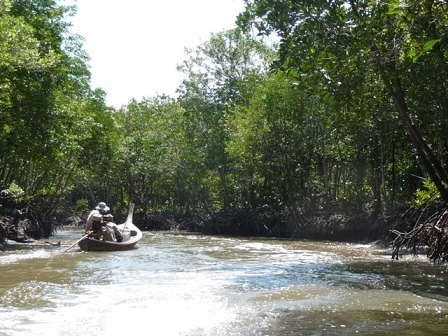Erstellt am: 21. 4. 2010 - 18:23 Uhr
The Treasure That We Don't Treasure
We were in a mangrove on the edge of the Andaman Sea in Thailand. The muddy channels were getting narrower. It was as if the forest was closing in around us, enveloping us in its aura of mystery.
The boat chugged slowly forward slowly forward through the dark, still water giving us a closer look of the gnarled roots. From a distance they looked like hopelessly tangled fishing nets, but now, up close and gleaming white in the sun, they reminded me of the piles of bones I'd seen in the huge underground ossuary in the catacombs of Paris. Only the fringe of the forest, draping down bright and green, looked cheerful.

chris cummins
The Earth’s mangrove forests are the natural treasure that we have traditionally refused to treasure – instead destroying them at a dizzying rate. When Alfredo Quarto, now the director of the Mangrove Action Project, started getting interested in the coastal forests they were still widely regarded as “mosquito infested wasteland”.
As their tropical homelands rapidly industrialized in recent decades, the world’s handsome green mangrove forests have made way for tourism development, shrimp farms, factories or even golf courses. Less than half of the planet’s original mangrove forests still exist and 20% of that loss has occurred in the past three decades. With catastrophic climate change already knocking on our doors, the widespread destruction continues. “We’re losing about 1% per year.” says Quarto, “That’s about 150,000 acres every 12 months.”

chris cummins
But worth of the mangroves is belatedly being recognized. This is partly down to lessons learned after recent natural disasters such as the 2004 Asian Tsunami and Myanmar’s horrific Cyclone Nargis. Mangroves provide natural buffer zones mitigating the effect of waves and storms. Where they were absent the force of nature was particularly devastating. In neighbouring Sri Lankan villages the tsunami death tolls varied dramatically according to the mangrove protection. In settlements protected by a deep mangrove zone it was often in single figures. In similar sized settlement just a few kilometers down the road, but this time where the mangroves had been cleared, thousands of coastal dwellers lost their lives.
Mangroves also fight the erosion of the rising seas and small islands are taking note. At the Copenhagen climate summit last December, mangrove planting was being touted as a last bastion against rising sea levels for the flat island nations such as the Maldives that lie so vulnerably in the Indian and Pacific Oceans.
They work the over way around too, mitigating the pollutant affect of agricultural development by absorbing excess nitrates and phosphates before they reach the sea and poison the fish that provide livelihoods for so many coastal communities. They also provide them with tannins for fishing nets wood for fuel and building material.
In less anthropocentric terms, the mangroves provide vital breeding grounds for our threatened biodiversity. The mangroves are havens for migrating birds and important nursery areas for many species of fish. Quarto told me that 75% of the tropical and subtropical fish species of the world spend at least part of their lives in the mangroves. Some feed of the nutrients that are absorbed into the water from the bark and the leaves; others hide among the labyrinthine roots. The forests provide temporary harbours for exotic sea-dwellers such as sea turtles and manatees.
As our boatchugged through the murky, tea-coloured waters of this particular Thai mangrove, a large lizard-like creature slithered ahead of our boat and into the dark shade of the forest. Crab-eating monkeys peered out from roots that curled like rib-cages before scampered off again into the undergrowth.
In the water there were the comic balloon fish and fish that looked like gawping giant trout, and the quick-swimming finned shark-like creatures the locals insisted were called “king fish”.

chris cummins
But is has been the mangroves role as a breeding ground for shrimp that has cursed them. The Western (and Japanese) appetite for those delicious alien-like pink little crustaceans is insatiable and farming them in the brackish waters where sea meets land has proved lucrative. Alfredo Quarto told me that up to thirty percent of recent global mangrove destruction has been due to clearing for shrimp farms. Quarto says it is particularly European demand that is causing the market to expand and ever more wetland areas to be cleared.
A consumer awareness campaign is necessary if this destruction is to be stopped but the fight to save the mangroves has never had the popular appeal of the campaigns to save the world’s rainforest or coral reefs. That’s a shame because, in fact mangroves and reefs share a symbiotic relationship – the reef protects the coast where the mangroves grow from being eroded by the sea, and the forest traps sediment washed from the land that would otherwise smother the reef. As Quarto puts it “If we want to save the coral reefs we have to save the mangroves.”
Last but certainly not least is the vital role of mangroves in sequestering carbon and turning it into useful nutrients. According to the February 2007 issue of National Geographic, “Mangroves are carbon factories… Measurements suggest that mangroves may have the highest net productivity of carbon of any natural ecosystem.” Their destruction is dangerous in two ways. When the forests are cleared much of the stored carbon oxidizes and adds to the greenhouse effect.

chris cummins
There is some good news for mangroves as we begin to grasp their worth:
The destruction of the forest continues but the speed of destruction has halved in recent years. Some countries, including low-lying Bangladesh, have actually managed an increase in mangrove area over time. Across the globe high profile re-planting projects have been initiated – but even they are not without controversy. Quarto says that, counterproductively, some new mangroves have been planted on other sensitive fragile wetland areas such as sea grass areas or salt-marshes.
“We need to make sure the mangroves are restored in areas where they belong,” says Quarto.


